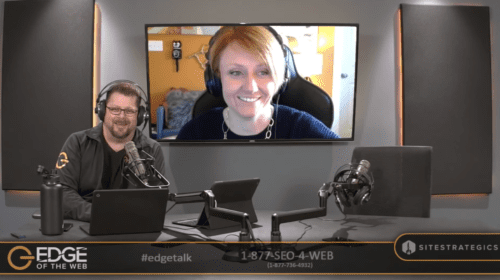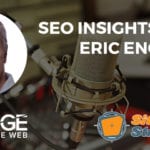Our special guest for episode 343 of the award-winning EDGE of the Web podcast was Susan Wenograd, VP of Marketing Strategy at Aimclear. Host Erin Sparks spoke with Susan about the thing she does best—Instagram story ads! Here’s what we learned:
Susan Wenograd: Her Background and Experience

Susan Wenograd is the Chief Marketing Officer (CMO) of Aimclear, an integrated digital marketing firm that handles everything from paid media to PR to email funnels, CRO, and everything else you can think of. The goal is to get all your digital marketing channels working together seamlessly. Susan is also a frequent speaker at national conferences such as SMX, Pubcon and Digital Summit Series, and regional gatherings such as SLCSEM and SEMPDX.
Susan started in e-commerce at circuitcity.com. She did content editing and email marketing for them for quite a few years, and then fell into PPC, which combined her love of words and copy with her love of metrics became. Susan started in paid search, and then became interested in Facebook ads in 2013 because it felt a little more similar to classic marketing to her. It had the mix of the creative part, as well as the targeting, as well as the math—everything she liked best. Facebook had only started with ads a couple years before that, so the changes have been huge since then. Same thing with Google Ads too. Paid social has taken up the lion’s share of her time because that’s where people need the most help.
The Changing Demographics of Social Media Platforms
According to Sprout Social, the number teenagers on Facebook is declining as more go to YouTube, Instagram, and Snapchat. It raises the question of how demographics play out among the different social media platforms.
If you’re doing ad buys on Facebook and Instagram, you really notice these kinds of shifts in how the ads are distributed, where most of the inventory is, and where most of the performance is. If you dig into research about why people are on different platforms, you quickly find out people are Facebook or Instagram for very different reasons. People on Facebook are there to catch up with friends and family and maybe find a little entertainment. People who go to Instagram, however, are there to be entertained, interact with brands, and see family and friends. There is a much greater expectation among Instagram users to interact with a brand, and to think of brands like people with personalities. That’s a big difference between those two platforms!
There are all kinds of ways people can incorporate interactive tools on Instagram. Facebook has always had its commenting and liking capabilities, but is trying to roll out similar tools like Instagram, but they’re not being widely adopted, which just further highlights the different demographics between the two. Facebook also suffers from saturation and people just ignoring the ads unless they’re very creative. That’s what’s working. Just because Facebook can very precisely target who you want to find doesn’t mean they’re going to look at your ad, and more so if it’s not super-creative. Get the creative right and you’ll stand out from the rest.
And yes, Facebook skews towards female and the over 45 crowd. That doesn’t mean targeting younger folks is useless, but there’s certainly not as much inventory for the younger users and it’s going to be more expensive to reach them on Facebook because of that.
The Evolution of the Instagram Story
One of the big differences on Instagram is how much time users spend in Instagram Stories as opposed to the feed. It was actually Snapchat that first came up with whole “story” concept. Then Instagram picked up on it and realized the younger set were way more into that than the feed, so it was only a matter of time until Instagram Story Ads came about. And they’ve rolled out interactive features in stories that were immediately widely adopted. Snapchat also had face filters, which is another thing Instagram adopted that caught on quickly. Instagram basically ended up beating Snapchat at their own game every step of the way. Now Facebook has “stories” but it’s really just not catching on like it has in Instagram, so the ad inventory for Facebook stories is very limited. It just doesn’t fit as well with its demographic.
The issue with Facebook is it’s trying to be all things to all people, but its users only go to it for a few things they want and largely ignore the rest. Instagram has figured out its demographic and has catered to it and plays to its own strengths with that younger demographic really well. It’s not trying to be all things to all people—it has a narrower focus that works really well.
What Will Kill Facebook?
Everyone likes to speculate on what’s the one thing that’s just going to kill Facebook. Susan is quick to point out that it won’t be one thing that kills Facebook—it will be 10 things. It will be the ten different platforms that each focus on one thing and do it better than Facebook because Facebook can’t do all things really well. Facebook is finally realizing that it cannot algorithmically select content for people and end up with happy customers. That’s why they’re pushing groups, so people will self-select more into content they want to see. In the bigger picture, it may be the Reddit’s approach with sub-Reddits that really shapes the future direction of social media. It lets people have more control over what they see, and people do want that control. People are already self-selecting to whatever platforms are the best at what they want, like Tik Tok for the short-video format. And LinkedIn Groups are way better than Facebook Groups. And Susan notes it’s a little scary when LinkedIn does anything better.
Instagram Story Ads
To really understand Instagram Story Ads, you have to go to Instagram as a user and spend some time viewing them like a user. You may think you “get it” but you probably don’t if you haven’t taken this step. It’s totally different from the feed experience. In the feed there are multiple things competing for your attention, but an Instagram Story ad is a full-screen experience with no distractions. So, while 15 seconds seems very short, it’s surprisingly long without distractions.
Unlike with a feed where users choose where to stop, in stories you don’t choose to stop, you merge onto the highway and then you decide if you’re merging left or merging right. It’s really important to understand what it’s like as a user because you’ll immediately see what looks really bad, like a landscape photo presented on the vertical screen of a phone (remember, this is a full-screen experience). A lot of Instagram ads are surprisingly bad, so pay attention to the creative.
You also have to understand how average users are posting their stories, how they use hashtags, stickers, polls and those sorts of things so you can create ad content that looks natural. If users can immediately tell it’s an ad, they can just swipe past it. You can only create good organic ads if you understand the style and characteristics of content users are posting. You can do text overlays in story videos, and there is not 20% text rule, which frees you up a lot on that front to get your message across. But it’s still only 15 seconds, so you have to use it well and not have so much text that people don’t have time to read and digest it. It can all be a big mind-shift for brands who aren’t used to the particulars of this type of content.
It’s also important to note that to get Instagram Story Ads right, you have to do a lot more testing because it’s harder to know ahead of time what kind of creative is going to be most effective. It takes some effort to figure out what users are going to like. But for many brands, getting this right results in much better performance on Instagram than Facebook, even at the top of the funnel. What you definitely cannot do is to just take what you’re doing in the feed and try to quickly bootstrap it into stories. That’s a recipe for failure.
Conversion ads aren’t working so well on Facebook (especially if it’s not a high-volume transaction scenario), but people are getting really good results with conversion ads on stories. This is interesting because story ads have low inventory, so you think it would be difficult for them to match lower inventory versus feed with lower conversion situations, but it does surprisingly well. That will probably change in the future as they add more inventory many cases than feed ads. Even if the conversion rate is lower, you’re paying so much less that it doesn’t really matter. For now the numbers still work in your favor when it comes to conversion. This means jumping in sooner than later to take advantage of all this, just remember to put the extra time and effort into getting the creative aspects right!
Connect with Susan Wenograd, VP of Marketing Strategy at Aimclear
Twitter: @SusanEDub (https://twitter.com/SusanEDub)
LinkedIn: https://www.linkedin.com/in/susanwenograd
Website: https://susanwenograd.com
AimclearWebsite: https://www.aimclearblog.com/home
Aimclear Twitter: @Aimclear (https://twitter.com/aimclear)
Aimclear Facebook: @Aimclear (https://www.facebook.com/Aimclear)
Aimclear LinkedIn: https://www.linkedin.com/company/aimclear
How Does Your Digital Marketing ROI Look?
If you can’t answer that question, then it’s time to get help with a Site Strategics report examining your SEO, content, social media, and PPC. Visit https://edgeofthewebradio.com/roi to get 30% off a comprehensive review of your digital assets!


